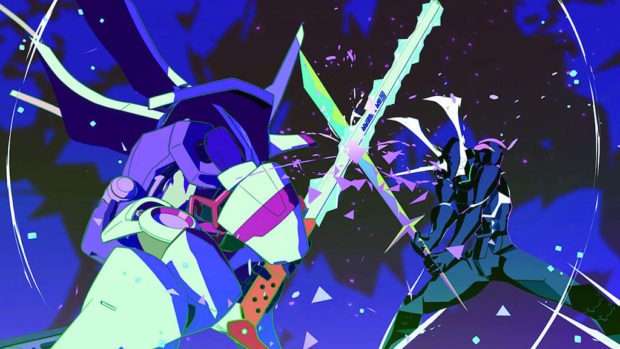The thing about PROMARE (プロメア) is that just when you think that it can’t get any crazier, the film bursts through the next thin boundary of common sense and stamps that line into oblivion. In other words, it just might be a Studio Trigger masterpiece.
Describing the plot to a film like this is like trying to catalogue each element of a Jackson Pollock painting, but here goes nothing. It’s been thirty years since the appearance of the Burnish, a group of flame-wielding mutants, destroyed half the world. When an extremist group called Mad Burnish emerges, Galo Thymos – a new recruit in the firefighting Burning Rescue brigade – goes up against Mad Burnish leader Lio Fotia. Yet he may not be the real villain.
From the opening credits, blending a kind of animated ‘documentary’ footage with the Benday dots of retro cartooning, PROMARE visually signals that it is going to be something different. In fact, it would be folly to try and follow this as if it were a traditional narrative, as director Hiroyuki Imaishi and writer Kazuki Nakashima have managed to tap into the collective unconscious of anime fans and given us a continuous train of thought of almost two hours.

Yet for the all of the seemingly chaotic shopfront, Imaishi and Nakashima exhibit a very savvy awareness of the conventions of modern anime. So much so that they use all of them: the tropes, inside jokes, visual parodies, genre transitions (from mecha to mock yaoi in a heatbeat), insane cutaways, and literal deus ex machinas. It’s almost as if they compressed several seasons of a show into a single film or wanted to make every anime at once. Either way it works.
The animation is unquestionably mind-blowing. While it may not be everyone’s cup of tea – pastel explosions, CG buildings, rectangular lens flare, and triangular ash – you never forget that you are watching something different. There’s one breakout sequence where the screen fills with a series of massive Burning constructs, each of them seeming to devour the last. At other times, seemingly random inserts will appear as a means of transitions between scenes. This film cares not for your rules.
In PROMARE we have a strange hybrid that is not only a tip of the hat to all the things the filmmakers love, but a weird tribute to itself as well. Fans of Gurren Lagann and Kill La Kill will recognise all the hallmarks of those shows (albeit turned up to 11), while everybody else can happily walk into this without any warning. The looks on their unsuspecting faces will be worth the price of admission.
2019 | Japan | DIRECTOR: Hiroyuki Imaishi | WRITERS: Kazuki Nakashima | CAST: Kenichi Matsuyama, Taichi Saotome, Masato Sakai, Ayane Sakura, Hiroyuki Yoshino| DISTRIBUTOR: Madman (AUS)| RUNNING TIME: 111 minutes | RELEASE DATE: 24 October 2019 (AUS)







